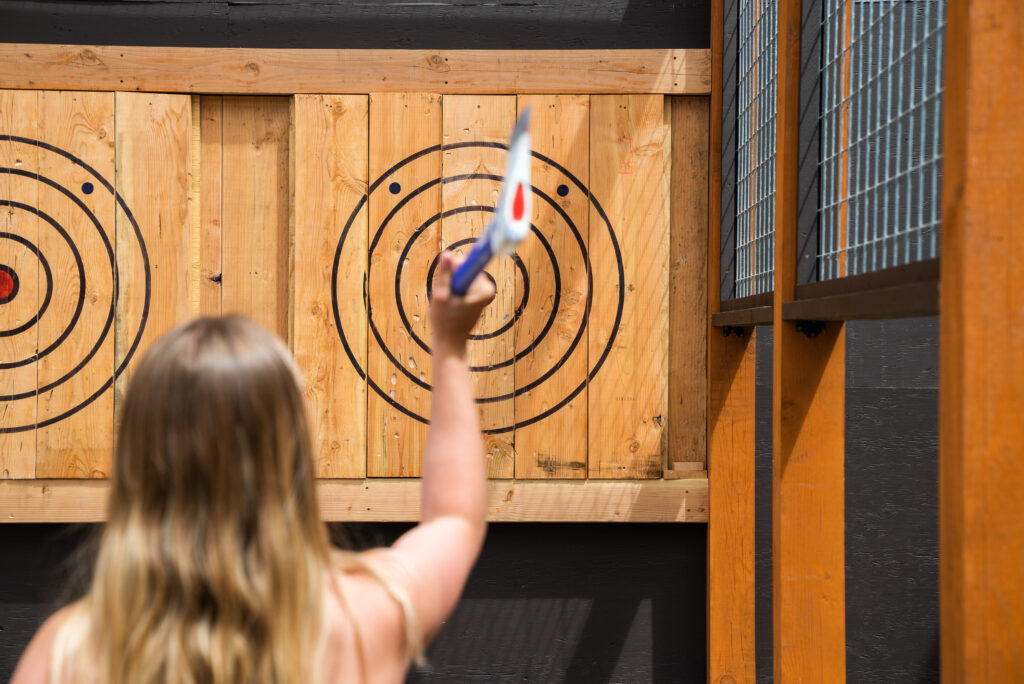Study the Axe Throwing Denver Scene: What You Required to Know
The Fun of Axe Throwing: Exactly How This Sporting Activity Combines Ability and Adrenaline for a Fun Time
Axe throwing has actually become a captivating sport that masterfully links the requirement for accurate ability with the thrill of adrenaline, offering individuals a appealing and distinct experience. The act of hurling an axe towards a target demands focus and strategy, concurrently cultivating an atmosphere of sociability and friendly rivalry. This intriguing blend of psychological emphasis and physical exertion has made axe tossing a preferred selection for those looking for both recreation and a feeling of accomplishment. To really appreciate the deepness and allure of this activity, one must consider its beginnings, the needed devices, and the fundamental techniques that ensure both safety and security and satisfaction.
The Origins of Axe Throwing
Axe tossing, a leisure activity that has acquired considerable appeal over the last few years, traces its roots back to ancient times. This primal sport go back to early human background, when axes were mainly utilized as tools and devices. The earliest records of axe use in affordable contexts are found amongst the Celts and Vikings, who tossed axes for sport along with in fight training. The practice was not simply an activity yet an important skill for survival and war.
Medieval European warriors, especially during the Middle Ages, exercised axe tossing as part of their martial training. The Francisca, a kind of throwing axe used by the Franks, ended up being iconic for its deadly accuracy. This standard weapon was made to be tossed at opponent shields and armor, showcasing its double utility in both sport and fight.
In even more recent history, axe tossing saw a resurgence in the logging camps of The United States and copyright in the 19th and 20th centuries. Lumberjacks would certainly participate in pleasant competition, evaluating their accuracy and strength by aiming at wood targets. This evolution from a survival skill to a recreational activity has actually paved the means for its modern-day rebirth, with dedicated places and leagues currently commemorating the sporting activity around the world.
Devices You Required
Recognizing the abundant history of axe tossing boosts the admiration of the sporting activity's contemporary iteration. Central to this thrilling task is the devices, which is important for both safety and security and performance. The primary tool is, certainly, the axe. For leisure and competitive axe tossing, the most generally made use of kind is the hatchet, typically evaluating between 1.25 to 2 pounds with a handle size of about 16 inches. The axe ought to have a sharp, properly maintained blade and a handle made from durable timber or composite material, making certain a great grasp and balance.
Similarly crucial is the target. Regulation targets are constructed from timber, with softwood ranges like pine or cottonwood being liked for their capability to absorb and hold the axe. The target is generally divided into five concentric circles, each with a certain point value, to assist in rating.
Safety and security gear, though often ignored, is vital. Safety handwear covers can enhance grasp and avoid sores, while closed-toed footwear are a must to protect feet from dropped axes (axe throwing denver). A well-lit, roomy tossing location, complete with safety and security barriers, makes sure a regulated setting where individuals can focus on refining their skills.
Standard Techniques Discussed
Understanding the basic techniques of axe throwing is crucial for both safety and proficiency. The first strategy to recognize is the grasp. Hold the axe with a firm, yet unwinded grip, comparable to holding a golf club. The leading hand must be placed straight listed below the axe head, while the non-dominant hand supports completion of the take care of.
Next, concentrate on the stance. Stand with your feet shoulder-width apart, ensuring your body is stabilized. Your dominant foot needs to be somewhat forward, aligning with your target. This positioning aids in keeping stability and guiding power properly in the direction of the target.

Security First
Making certain security Resources in axe throwing is critical to producing an injury-free and enjoyable experience. Safety and security gauges start with the place layout. A well-designed axe throwing facility features clear demarcations between tossing lanes, tough backgrounds to capture roaming axes, and non-slip flooring to avoid crashes. In addition, ample illumination is essential to assist participants keep visual accuracy and spatial recognition.
Advantages of Axe Throwing
Axe throwing offers a myriad of advantages that expand past basic entertainment. The repetitive movement of throwing the axe also improves hand-eye control and great electric motor abilities.
Psychologically, axe tossing calls for focus, approach, and precision, making it an excellent method to develop cognitive abilities. The focus needed to hit the target can act as a form of mindfulness, enabling individuals to remove their minds and reduce stress and anxiety. This mental interaction can be specifically advantageous in assisting people develop much better analytic abilities and psychological durability.
Socially, axe throwing is frequently appreciated in team setups, promoting team-building and sociability. Whether as part of a company occasion see this page or a laid-back getaway with close friends, the sporting activity motivates interaction and cooperation. Furthermore, the communal experience of finding out and enhancing together can enhance relationships and produce long-term memories.
Final Thought

The earliest documents of axe use in affordable contexts are located amongst the Celts and Vikings, who threw axes for sport as well as in fight training. Launch the axe when your hands are approximately at eye level, permitting the axe's natural turning to assist it towards the target.
A well-designed axe tossing center features clear separations between throwing lanes, strong backdrops to capture roaming axes, and non-slip floor covering to avoid mishaps. Individuals have to be advised on the correct way to toss the axe and handle, stressing managed, purposeful motions over strong throws.
In summary, axe tossing stands out as a sport that masterfully incorporates adrenaline, ability, and precision.